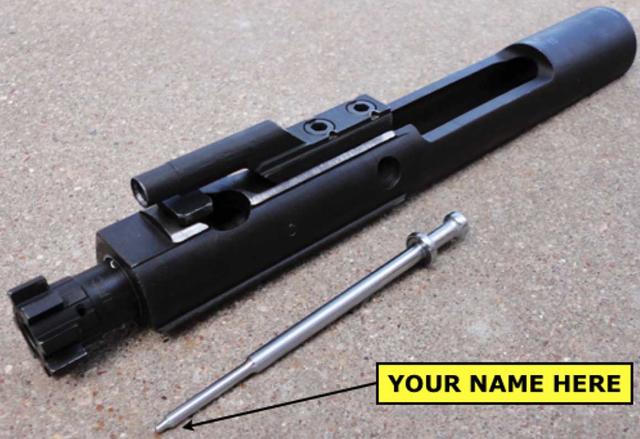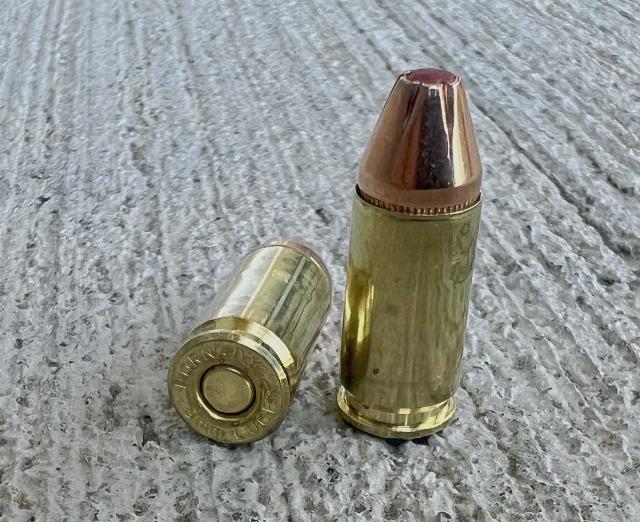The microstamping scam
Among the never-ending attempts of anti-liberty/gun cracktivists to deprive Americans of their unalienable Second Amendment rights are various microstamping schemes. Microstamping requires leaving a unique imprint on the primer of a cartridge case. The only potentially workable means of doing this is laser engraving the tip of a firing pin with very small letters/numbers. Some microstamping schemes demand a second unique imprint, but on the expended case as well as the primer.

Graphic: firing pin. Author.
What, you might ask, is the point? Is microstamping a valid crime fighting tool? No. The point is making firearms more expensive, and harassing law-abiding gun owners in any way possible. In my law enforcement career, I never solved a case through fingerprints, nor was I aware of anyone that did. Trying to solve a crime with a microstamped primer would be even less productive.

Graphic: cartridges and primer. Author.
The second imprint method has never been proved even remotely viable, so we’ll stick to the firing pin method. Primers are not uniformly hard, even those from a single manufacturer, so imprints are iffy. A dirty gun might make no imprint. It would take only a few minutes with an abrasive to remove the laser engraving, and microstamping schemes apply only to semiautomatic handguns, which eject expended cases as part of the firing cycle. Revolvers do not.
Any microstamping scheme is of necessity a gun registration scheme, because without a massive national database containing an image of a microstamped case from every gun in America, there’s no way to identify from which gun that case came. For now, it’s against federal law for government to maintain a gun registry, which doesn’t mean government isn’t trying to do it under the radar. Even so, the only case images they’d have on file are from semiautomatic handguns manufactured after a federal microstamping law went into effect. Hundreds of millions of handguns would be unaffected and essentially untraceable.
Even if a criminal doesn’t file the engraving off a firing pin, all they have to do is replace the firing pin, use a revolver, or stop a few seconds to collect their expended cases. Even better, they can visit a range, collect a variety of cases, and spread them around their crime scenes, sending hapless police on wild goose chases.
Imagine you’re a police officer investigating a murder in a dark alley. The shooter left behind a microstamped case. Ah-hah! Case solved! First, a blown-up image in the correct computer format must be made in the high-tech crime lab virtually no police agency outside of TV crime dramas has. Then that image must be entered into the massive federal database—which doesn’t exist—which may or may not provide a match. Remember the hundreds of millions of guns that don’t microstamp?
For the sake of argument, let’s say the computer spits out 30 or so potential matches. Now a government examiner must review those potential matches. Many are only partials—primers aren’t uniformly hard, and a used firing pin isn’t going to make good imprints anyway—but let’s say this time you get lucky and a positive match is found. It’s to a 9mm S&W handgun purchased by John Q. Citizen of 1234 Pleasant Lane, Anytown, Anystate four years earlier. Ah hah! Case solved! All you have to do is arrest Citizen and he’ll give a tearful confession.
Not so fast, Sherlock.
The problem is probable cause. At this point, you don’t have enough PC to even get a warrant to search Citizen’s home. What information do you have to convince a judge the gun he bought four years earlier might be there rather than in his car, or somewhere else? Warrants are annoyingly specific things. But let’s say you manage to get a judge in Anytown, which is three states away from your state, to give you a warrant to search Citizen’s home. You show up and discover he moved out of state last year.
Even if you eventually found Citizen still owned the gun, you have to prove he was in that dark alley that night, with the gun, and that he fired it at the victim, killing them. What’s most likely is you’ll discover citizen sold the gun to a friend from whom the gun was stolen three years ago, and you’re nowhere. Most criminals don’t buy guns retail. They steal them or otherwise acquire them under the legal radar.
But none of that matters because there is no federal registration database—it’s illegal.
And do you really think the people who push microstamping schemes, the same people who decriminalize crime, defund and harass the police, refuse to prosecute criminals, and refuse to impose meaningful sentences in those few cases where crooks are prosecuted, really care about combatting crime? They do, but only if you’re not really a criminal.
That the real point of microstamping.
Mike McDaniel is a USAF veteran, classically trained musician, Japanese and European fencer, life-long athlete, firearm instructor, retired police officer and high school and college English teacher. He is a published author and blogger. His home blog is Stately McDaniel Manor.
FOLLOW US ON
Recent Articles
- The Death of the Center-Left in America
- ‘Make Peace, You Fools! What Else Can You Do?’
- When Nuclear Regulation Goes Awry
- The Danger of Nothing
- A New Pope With Courage
- Not in Kansas Any More
- Democrats Dying on the Most Desolate Hills
- If She’s an Astronaut … I’m a Jet Fighter Pilot
- Is the Jihadist Trojan Horse Winning?
- Who Has the Best American Autobiography?
Blog Posts
- Mexican ammo wranglers
- Rep. Jamie 'Maryland Man' Raskin also threatens Trump supporters
- The eight narrative fallacies that drive American politics
- Summertime reality twisted into climate exasperation
- Life discovered on a distant planet?
- The answer is not blowing in the wind
- Letitia James: it's either/or
- Harvard elitism meets Donald Trump
- The GEC is finally more than mostly dead
- We're not the same
- Hillary ‘the Russia Hoaxer’ Clinton wants to imprison people for ‘propaganda’
- Rep. Jamie Raskin threatens foreign leaders who cooperate with President Trump, 'when we come back to power — and we will'
- Maybe we need more living versions of “Hillbilly Funerals”
- A female fencer's courage is partly rewarded
- Democrats' Cloward-Piven default






